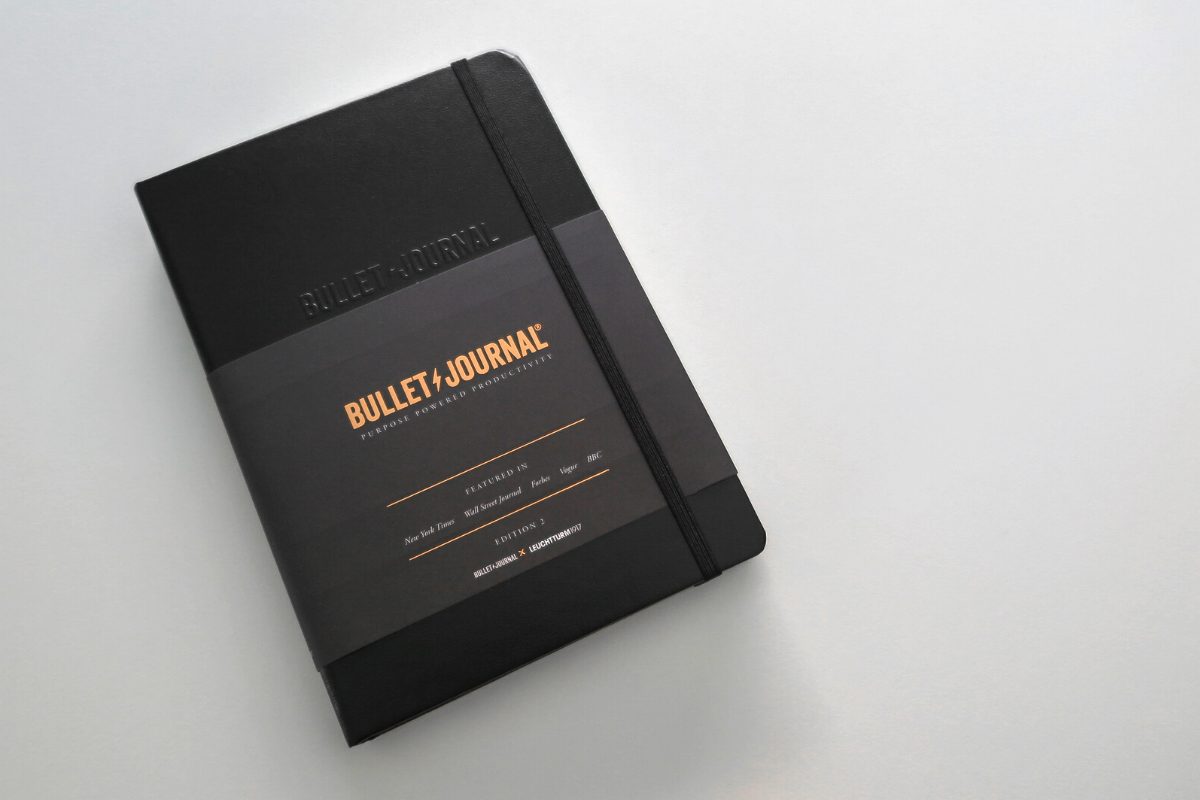New Year, new Bullet Journal! Setting up Bullet Journal is one of my favourite New Year’s activities. Here’s what my 2023 Minimalist Bullet Journal setup looks like.
What is a Bullet Journal?
The Bullet Journal is an organisation system created by Ryder Carroll, a digital product designer based in New York. The Bullet Journal is a handwritten notebook that contains all your to-do lists, brainstorming, notes, and other organisational tasks. It gets its name from using dot journals and bullet points to log information.
The core elements of the Bullet Journal are:
- Index: The Bullet Journal has numbered pages, and an index at the front helps you find what you need.
- Logs: The original Bullet Journal contained a monthly calendar, task list, and daily calendar. Many users today add a future log to have an overview of the year and a weekly log.
- Rapid logging: Rapid logging is part of the daily logging system in which you take quick notes.
- Collections: A collection is a group, such as related tasks, a project, or a list of books you want to read.
- Migration: Migration involves moving one day’s uncompleted tasks to another day to remain visible.
Since Ryder Carroll shared it online in 2013, the Bullet Journal has become very popular. People use it for work, school, finances, habit tracking, and mental health.
Ryder Carroll’s original system is straightforward, but the Bullet Journal’s flexibility has led to many styles. If you google it, you’ll see many examples of artsy journals. Unfortunately, the Bullet Journal aesthetic sometimes overwhelms and discourages people from trying the system. That’s why I like to share my Bullet Journal. My approach is close to the original, sometimes referred to as a minimalist style.
My 2023 Minimalist Bullet Journal setup
I adopted the Bullet Journal in 2015, and I’ve always kept it simple, but 2023 is my leanest journal.
From 2015 to 2021, I used a Moleskine journal and went from the softcover grid to the hardcover dot. In 2022, I bought the black Bullet Journal Edition 2, a collaboration between Ryder Carroll and Leuchtturm1917. I bought it again for my 2023 journal.
I love the Moleskine brand and have several of their journals. Still, I prefer the Leuchtturm1917 for the Bullet Journal because it’s designed for that and has convenient features such as a grid guide, page dividers, wider margins, numbered pages, three bookmarks (Moleskine has two), and stickers. Although the Leuchtturm1917 has fewer pages than the Moleskine (206 versus 240), the paper is heavier (120 g/m² versus 70 g/m²), and there’s less ghosting. I love the smooth feel of the pages.
The Bullet Journal appeals to me because it’s a blank canvas, and I can make it what I need. Other planners with printed templates and prompts don’t work for me. I don’t love that the first 11 pages of Leuchtturm1917 Bullet Journal Edition 2 are titled, but it’s far from a dealbreaker.
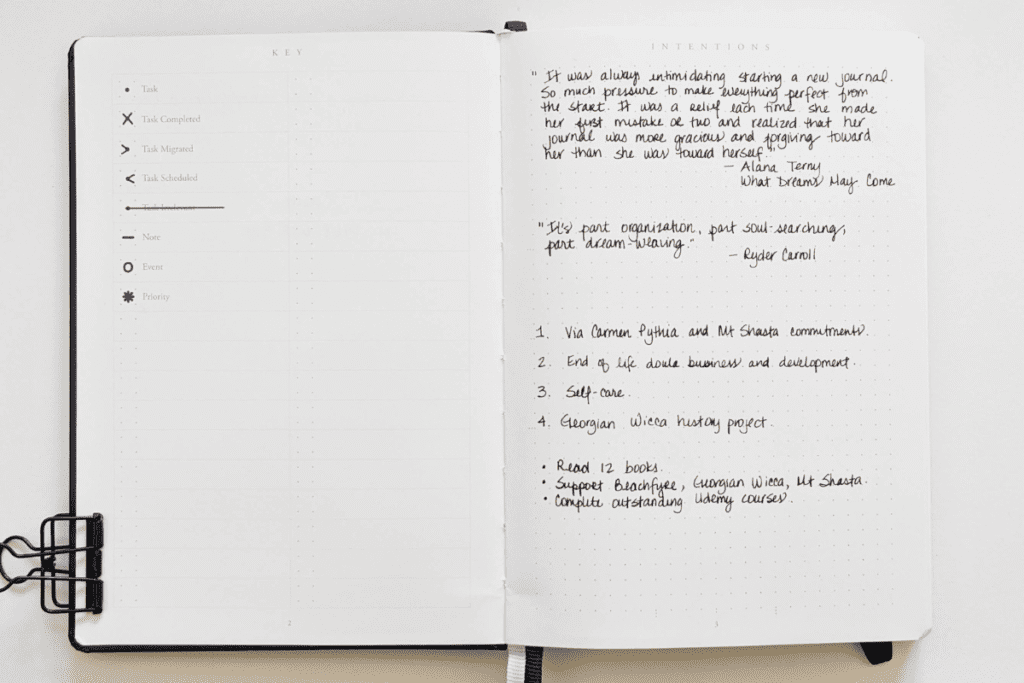
The first spread has the key and intentions pages. I last wrote a key in my Bullet Journal years ago. After all these years, I’ve developed my system based on the original. For example, I prefer checkboxes over bullet points for tasks and bullet points over dashes for notes. This is second nature to me, and I don’t need to write it down. For the first time since I began using this method in 2015, I wrote down my 2023 goals on the intentions page.

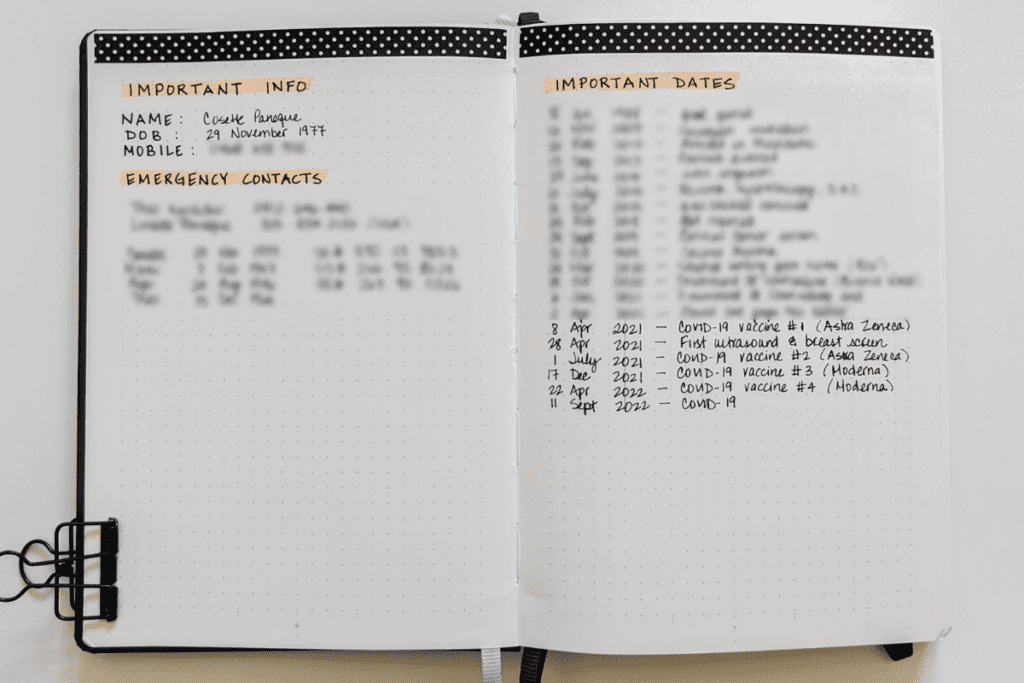
After the key and intentions spread, there are two spreads for the index; I only need one. Last year, I covered the titles with correction tape. I used washi tape this year and turned the second index spread into my first collection: Important Info.
Important Info used to be one page, but it’s a spread this year. This is important information at a glance. It’s primarily dates, such as when my IUD was inserted, my last cervical cancer screen, and my COVID-19 vaccines. Some of this information is captured elsewhere, such as My Health Record, Australia’s national digital health records platform, but flipping to this page is quick and easy. I also added emergency contacts to this spread for the first time.
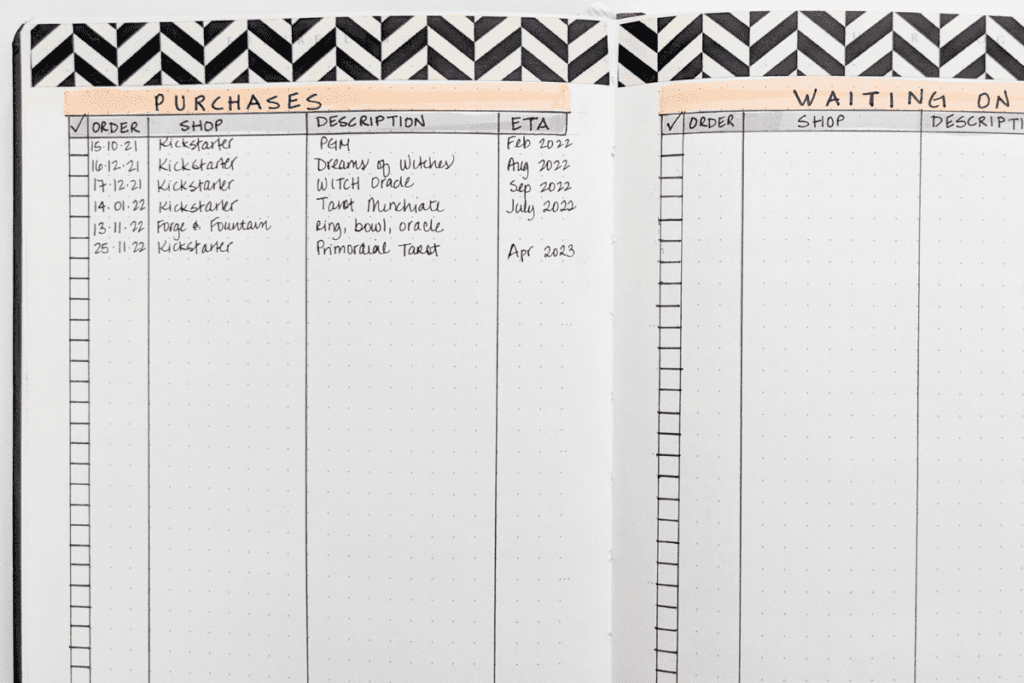
Two spreads for future logging follow the index. I covered the labels on the first spread with washi tape and made this my second collection: Purchases Waiting On. This is where I keep track of my online purchases, particularly those that will take weeks and months (and even years, as with some Kickstarters).
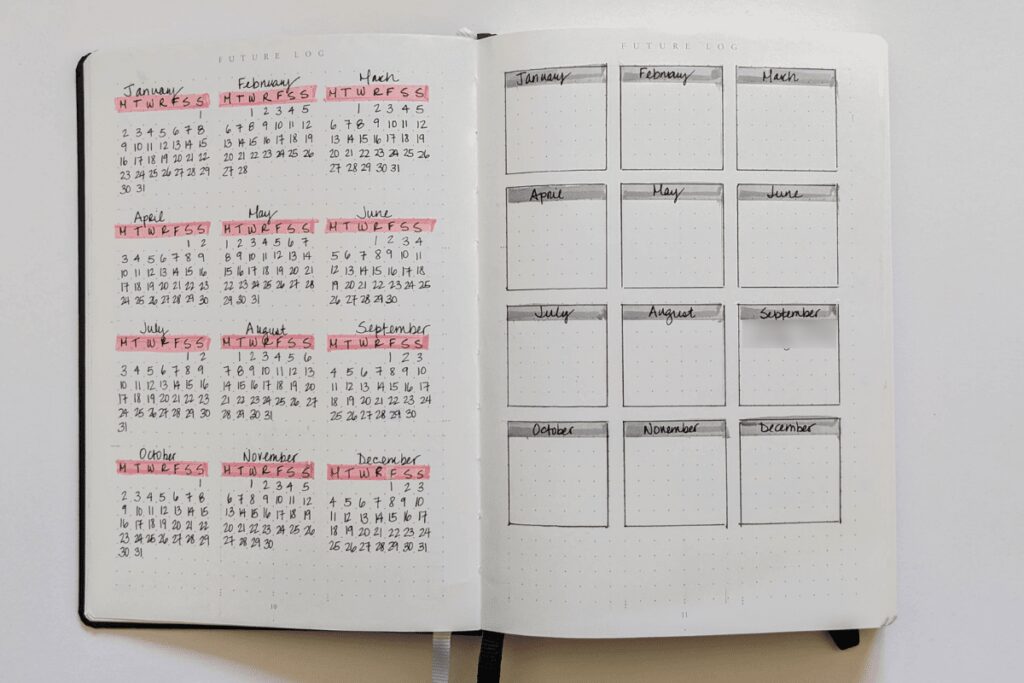
The next spread is my future log. In the past, I’ve tried vertical future logs, horizontal ones, and none at all. I rely heavily on my Google Calendar, which is busy and changes frequently. Rather than having a granular calendar in my Bullet Journal, I use it to get an overview of the year, highlight significant events, and track my menstrual cycle.

My next spread is the month of January. In the past, I’ve dedicated the left page to the monthly calendar and the right to the tasks. My reliance on my Google Calendar means I only need so much calendar space in my Bullet Journal. So, my monthly log now shares a page with spaces for ideas, achievements, and gratitudes. The other page is still for tasks, and I’ve divided it into four spaces to reflect four main working areas.
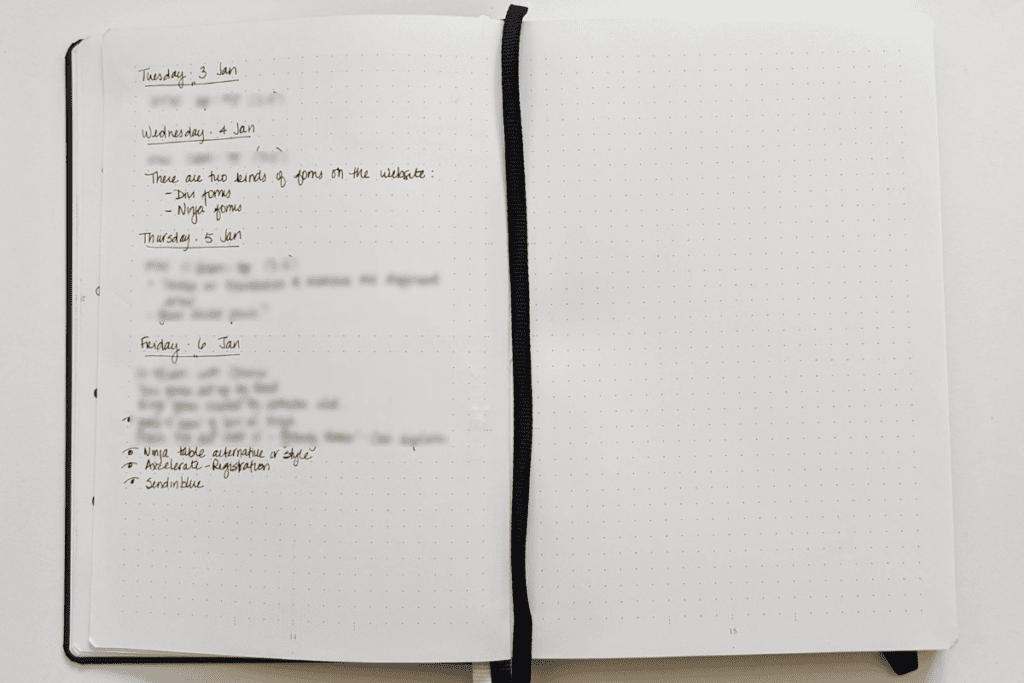
The following pages are blank. Here begin the daily notes, rapid logging, etc. These pages are a chaotic mix of my day’s work, notes from meetings, brainstorming, planning, and so forth.
What's not in my Bullet Journal
Many things didn’t make it into my Bullet Journal this year. These are primarily collections I’m now storing elsewhere. For example, I keep track of books on Goodreads, and I use Notion heavily. The weekly log comes and goes as needed.
My Bullet Journal contains a limited amount of spiritual content because this is stored elsewhere. For example, my Book of Shadows is a physical book I wrote when I was initiated. I write other materials in Word documents and have digital files. I don’t keep lists of correspondences in my Bullet Journal because I already know them or have reference books and websites.
I think of my Bullet Journal as a temporary tool for being productive now. I have started noting my weekly tarot cards and some immediate astrological events because these can influence my day or week. I don’t generally use a Bullet Journal for information I want beyond the year.
What about pens?
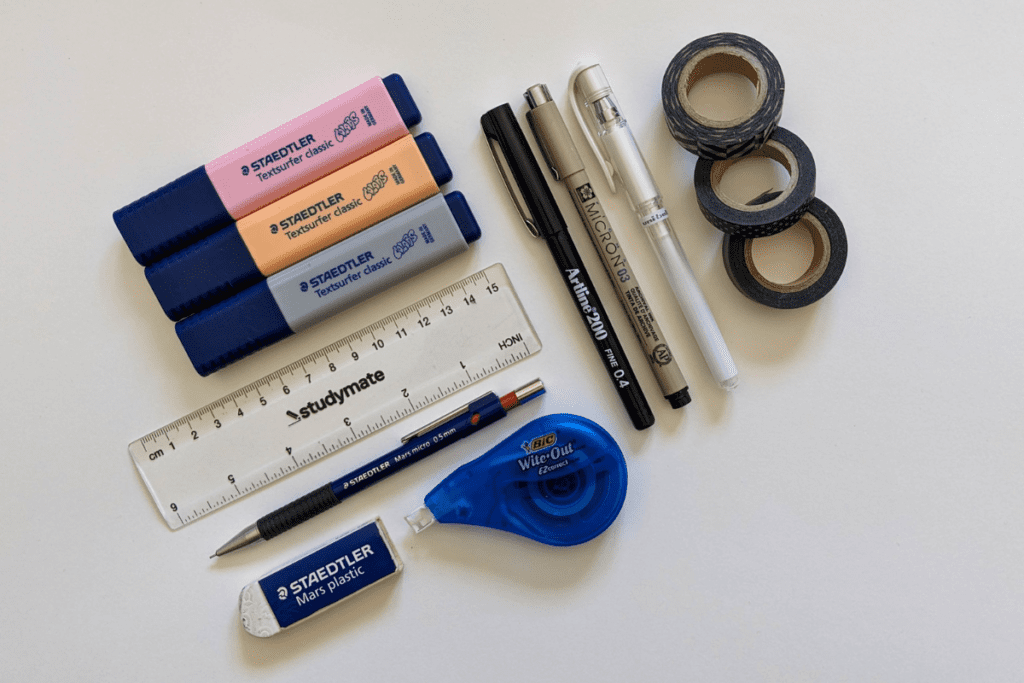
We stationery lovers often ask what pens a person uses.
My favourite pens at the moment are Pigma Microns. I’ve been using the Pigma Micron 03 for everyday writing in my Bullet Journal. Another reliable pen I love is the inexpensive Artline 200 Fine 0.4 in black.
The Leuchtturm1917 Bullet Journal Edition 2 has rose gold accents, so I like using Staedtler Textsurfer Classic highlighters in pastel colours–light carmine, peach, and light grey.
Other supplies I rely on are:
- a Staedtler Mars Micro 775 Mechanical Pencil 0.5mm
- a Staedtler eraser
- correction tape
- a white gel pen for corrections
- a 15-cm clear plastic ruler
- three rolls of washi tape (my entire collection)
That’s it! That’s my 2023 Bullet Journal setup.

